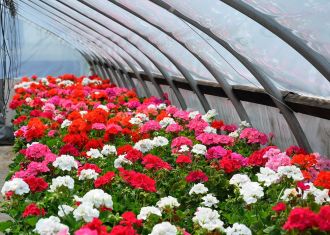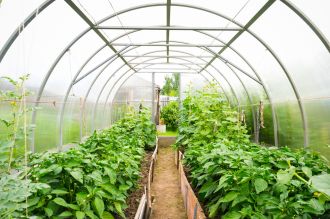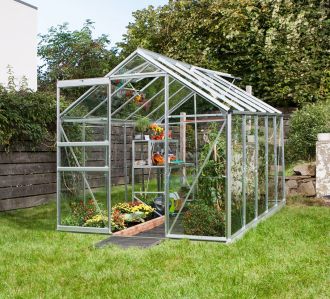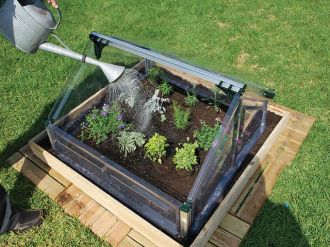Do-it-yourself foundation for a greenhouse from a bar

The construction of a foundation for a greenhouse from a bar begins with digging a shallow trench according to the size of the future greenhouse. First of all, the axes of the greenhouse frame are marked on the ground. For this, a cord and pegs are used, which are driven in at the intersection of the long and short sides of the greenhouse according to the size of each side. Further, stepping back from the axis by 10-20 cm in both directions, the pegs are hammered again, onto which a cord is pulled, limiting the size of the groove in width. This is provided that the beam for the foundation of the greenhouse will be used in the size of 12x12 cm.
When choosing a timber, you need to carefully examine the material so that there are no visible traces of the woodworm beetle, so that there is no blue on the wood, many deep knots. The beam must have clear geometric dimensions and shapes. The moisture content of wood should be kept within 20-22%.
You will be lucky if you can buy larch lumber, which is the most durable material among trees in terms of service life in all weather conditions.
If the greenhouse is planned to be large, then the beam for the foundation can be taken with a large section or made of several rows from a beam of a small section. In this case, the groove for the foundation for the polycarbonate greenhouse will need to be dug to a greater depth.
The groove is dug to a depth of no more than 10-20 cm, purely so that there are no gaps under the foundation and cold air penetrates inside the greenhouse in early spring or late autumn. At the bottom of the excavated ditch, roofing material or roofing felt is laid for waterproofing the beam, so that the roofing material wraps the beam from three sides - from below and from the sides.
The beam is pre-treated with appropriate antiseptics and dried.
In the factory, impregnation with antiseptics is carried out by completely immersing the wood in an antiseptic solution for a certain time. It would be nice if there is such a container on the site so that the timber is completely saturated, since simple brushing with a brush or roller does little good, therefore the durability of wood as a foundation is limited to a maximum of 7-10 years.
In the corners, the timber is connected in any way used in the construction of wooden houses - into a spike, into half a tree or otherwise. For greater strength, the corner joints of the beam are planted on dowels (wooden rods with a diameter of 20-30 mm). Modern craftsmen prefer to use metal plates or corners in which there are ready-made holes for nails or self-tapping screws.
Advantages of a wooden foundation
Choosing the option of a foundation for a greenhouse from a bar, the owner of the site receives the following advantages:
- the speed of foundation construction;
- ease of installation and dismantling if necessary;
- the possibility of using the timber subsequently for other purposes;
- when the greenhouse is transferred to another place, there are no traces of its stay in the same place.
It is necessary to move the greenhouse so that the soil under it does not deplete, otherwise it will be necessary to change the entire fertile layer in a few years, and this is a big and difficult job.
Disadvantages of a wooden foundation
Before you make a foundation for a greenhouse, you need to know about the material from which it is planned to build, both the greenhouse itself and the foundation for it. Any material has not only advantages, but also disadvantages. Wood has the only drawback, which is the inability to resist decay in a humid environment. A greenhouse is just such an environment. And the soil here is constantly moist and the air itself is saturated with moisture vapor from constant watering and from plants growing in the greenhouse.
The owner of the site always retains the right to choose whether to build a foundation of wood or use other materials, but I just want to talk about the options.
 Flower arranging and designing will help you make more profit from your greenhouse. Some of the flowers and foliage you use can be grown in your greenhouse or gardenŚother material will have to be purchasedŚpreferably from a wholesaler, if one is accessible to you.
Flower arranging and designing will help you make more profit from your greenhouse. Some of the flowers and foliage you use can be grown in your greenhouse or gardenŚother material will have to be purchasedŚpreferably from a wholesaler, if one is accessible to you.




Comments on this post are no longer accepted.